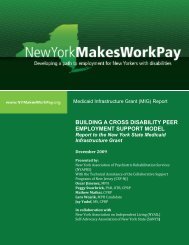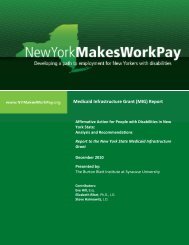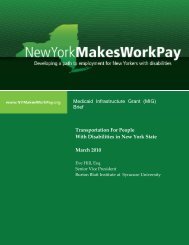Disability & Employment Law in New York State - Cornell University
Disability & Employment Law in New York State - Cornell University
Disability & Employment Law in New York State - Cornell University
You also want an ePaper? Increase the reach of your titles
YUMPU automatically turns print PDFs into web optimized ePapers that Google loves.
<strong>Disability</strong> & <strong>Employment</strong> <strong>Law</strong> <strong>in</strong> <strong>New</strong> <strong>York</strong> <strong>State</strong>:Analysis and Recommendationslevels. Part II draws on relevant statutes and court decisions <strong>in</strong> order to review thefundamentals of disability discrim<strong>in</strong>ation claims, and advance a comparison betweenstate and federal law. Part III reviews laws specific to state government employees (i.e.civil servants). Part IV looks at the law specific to <strong>New</strong> <strong>York</strong> City, which expands on theprotections available under the state law. Although <strong>New</strong> <strong>York</strong> City law does not apply tothe rest of the state outside of its borders, it has some <strong>in</strong>fluence and provides a usefulcomparison. Part V briefly compares <strong>New</strong> <strong>York</strong> to other states, to consider differ<strong>in</strong>gapproaches to disability civil rights at the state level. F<strong>in</strong>ally, Part VI summarizescomparative advantages between us<strong>in</strong>g city, state, and federal law to combat disabilitydiscrim<strong>in</strong>ation, and makes recommendations for us<strong>in</strong>g and improv<strong>in</strong>g the laws, <strong>in</strong> orderto <strong>in</strong>crease employment of people with disabilities.I A Brief Introduction to <strong>Disability</strong> Civil Rights<strong>Disability</strong> civil rights laws build upon the legacy and pr<strong>in</strong>ciples of race and gender civilrights laws. However, there are important differences. Whether under Constitutionalequal protection standards, or civil rights models grounded <strong>in</strong> a Constitutionalconception of equality, race or sex discrim<strong>in</strong>ation are often found to be legally presentwhen persons are treated differently based on the demographic category. Becauseevery person has a race and a gender, civil rights approaches to race and sex do notrequire great attention to def<strong>in</strong>itions of protected categories, nor do they necessarilylimit protections only to particular racial or gender groups. Thus, so-called “reversediscrim<strong>in</strong>ation”claims by members of majority race or gender groups are possible. Raceand gender discrim<strong>in</strong>ation laws generally call for race- or gender-neutral approaches toachieve equality. These civil rights laws generally do not call for affirmative race- orgender-specific remedies.In contrast, disability is commonly understood to be more than a social, or sociallyconstructed, difference. <strong>Disability</strong> civil rights laws recognize that barriers fac<strong>in</strong>g peoplewith disabilities are not merely attitud<strong>in</strong>al, but are <strong>in</strong>corporated <strong>in</strong>to the builtenvironment, communication mechanisms, and otherwise neutral policies. Our legalsystem presumes that equality based on disability cannot be achieved through identicaltreatment. Thus, disability rights laws often require disability-specific responses, such asreasonable accommodations, policy modifications, auxiliary aids, and physical changesto facilities. Therefore, <strong>in</strong> order to avoid creat<strong>in</strong>g rights to “special” or “preferential”treatment for people who do not need it, disability civil rights protections have generallybeen limited to people who fall with<strong>in</strong> the legal def<strong>in</strong>ition of persons with disabilities; thecoverage is always for a discrete class of persons. The def<strong>in</strong>ition of disability has,therefore, been the subject of much litigation and debate.However, more recently, policymakers have begun to re-exam<strong>in</strong>e the need for a narrowdef<strong>in</strong>ition of the protected group, recogniz<strong>in</strong>g that unfair discrim<strong>in</strong>ation on the basis ofdisability should be prohibited, not just for people with severe disabilities, but for peoplewith all levels of disabilities. Thus, both <strong>in</strong>dividuals with severe disabilities, such asbl<strong>in</strong>dness, and <strong>in</strong>dividuals with less severe disabilities, such as near-sightedness,should be protected from impairment-based exclusion or other discrim<strong>in</strong>atory treatment.Moreover, because the disability-specific remedies (e.g. accommodation, auxiliary aids)envisioned are limited by “reasonableness” and “effectiveness,” the eligible group does2





